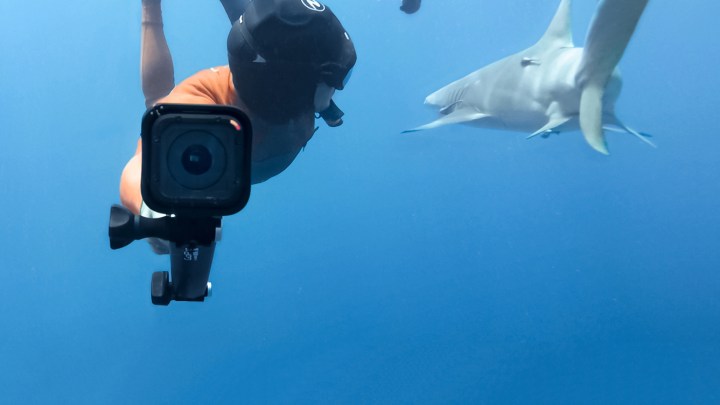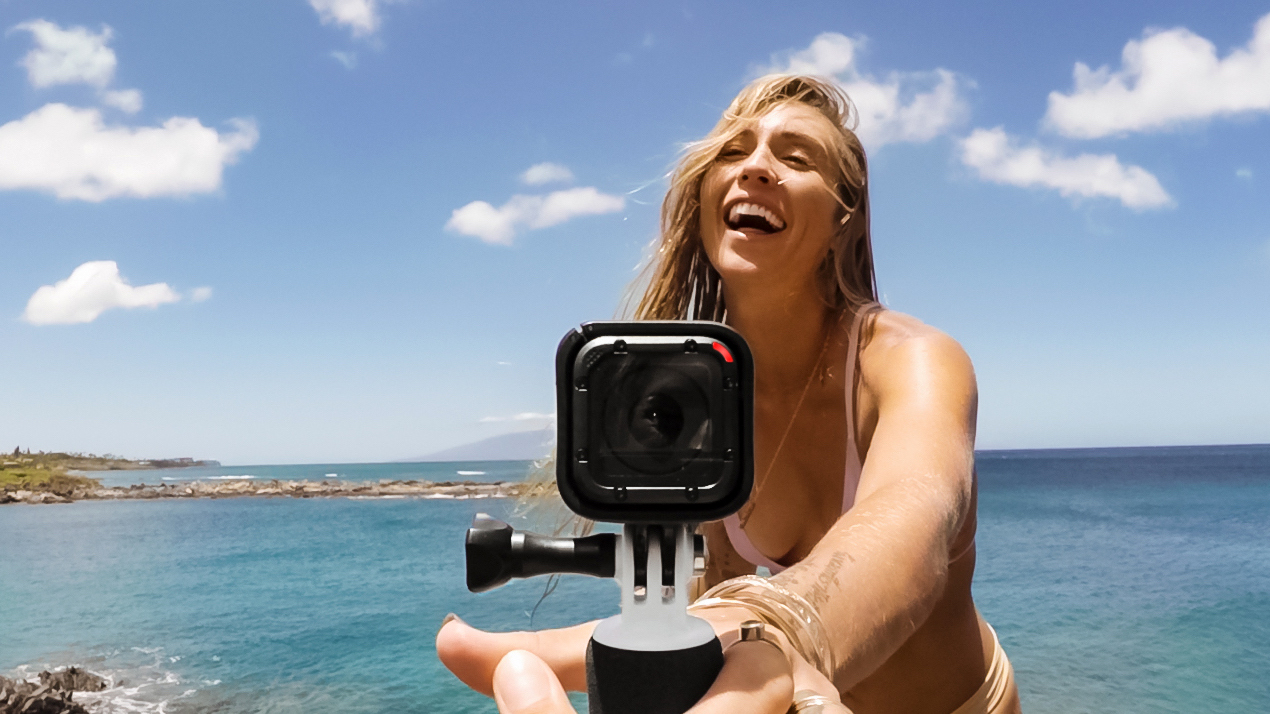
“This next launch will be the most important product launch in [its] history, as GoPro enters a new category, hones their media empire and flexes their muscle as the dominant brand in the POV category,” Scott Peterson, a senior analyst for Gap Intelligence, told Digital Trends.
Fans likely won’t have to wait long to find out what GoPro has up its sleeve.
While we know the camera’s arrival is imminent, other details are scant (official ones, that is). And although the company’s stock has begun to pick up, the features of the next Hero camera (and drone) could determine just how quickly it recovers, according to analysts.
So, what’s next for the Hero5? Digital Trends asked two industry analysts to look into their crystal balls and weigh in on what GoPro’s next flagship model could include – or perhaps, should include – from both a hardware standpoint and the way the company is poised as a whole.
Hero5 should be a flagship action cam
Last year, GoPro ventured into the budget action cam market, and it didn’t go well. Industry experts expect new flagship models, not low-price options.
“They used to have a simple product line – momma bear, papa bear, and baby bear,” Peterson explained. “Then, they added the Hero+ and the Hero + LCD and they blew up their own formula, which was simplicity and a clear product line – they muddied it up.”
As an analyst that reports strategic research on the camera market to multiple companies, including GoPro, Peterson has predicted GoPro’s moves before – including the recent price slash on the small Session camera. The Hero+ and Hero+ LCD were GoPro’s attempt to compete with third-party brands offering budget-priced action cams, but it discontinued those budget models in April after disappointing sales.
While the Session was originally not priced as a budget camera, two price cuts that left the camera at half of the initial list price (from $400 to $200) made the tiny camera GoPro’s most affordable option. When it cut the price, it also rebranded the camera, eliminating the Hero4 from the name and just calling it the Hero Session. The removal of that model number hints that the Session won’t be updated along with the Hero4 Black and Silver.
Analysts expect GoPro to return to its roots with a flagship action camera. Doing away with the budget options, Peterson said the Hero5 needs to return to the leader board for their spec sheets, since the Hero4 no longer has the best features on the market.
Pinpointing what a well-endowed action camera will include is tricker. 4K is expected, and is currently offered in the Black but not the Silver. Alan Bullock, the associate director of connected imaging trends for InfoTrends, expects that high-resolution will be enticing beyond its 4K capabilities. The higher resolution makes it easier to add elements like digital image stabilization and footage cropping, he explained. With 4K, there’s more room to do that without degrading the quality.
However, price still needs to justify the specs. “I think that the Hero5 also needs to be affordable,” Bullock said. “They took a hit when they had to drop the price on their last camera a few times.”
It should have auto recording and voice control
One of GoPro’s pain points, Peterson explained, is that action cameras are often used in an environment that makes it difficult to stop and start the recording on time, resulting in the need to sort through long clips for a 30-second highlight.
Peterson suggested that more integrated sensors could also introduce new recording options, explaining that lifelogging cameras have speed sensors and face detection that automatically start recording when those sensors detect something out of the ordinary, like a sudden increase in speed.
Sensors – whether that’s voice, speed, or even altitude – could help by automatically tagging the footage and making the sorting process simpler, or by magically starting and stopping the footage itself. The camera could record a few seconds before starting and a few seconds after stopping, Bullock said. If features like that are included on the next Hero camera, it would be a big help.
A supposed leak of an incomplete instruction manual suggests GoPro may add voice commands to start and stop recordings, although there are questions on the manual’s legitimacy, including font differences in some sections. There’s nothing to confirm if the leaked manual offers a legitimate look at the Hero5, but voice control would help address the difficulty of starting and stopping a recording at the right time, if you’re in the middle of the action.
Bullock does caution that the rumored voice control may be hard to use in many of the environments that GoPros typically excel in. “Many of the environments where action cameras are used might be difficult to use voice control unless they have microphones that can tune in to the user and strain out extraneous noise,” he said.
It should easily live-stream, and have LTE
Wi-Fi is standard for using GoPro with a smartphone or remote, but connectivity is one avenue GoPro could decide to expand. Although CEO Woodman has said the Hero5 would be GoPro’s “most connected and convenient” camera ever, the predictions were a bit cloudy. But it’s a good bet GoPro is working on something unique involving connectivity.
One possibility is live-streaming, which is rapidly growing in popularity, thanks to services like Facebook Live and Twitter’s Periscope. While streaming large files like 4K live can be tough to do, it could give the next GoPro an edge in easier sharing.
Another prediction is cellular LTE connections, though Bullock said that feature would have a smaller audience of people willing to pay for that service.
It should have a cloud backup service
With the next set of GoPro products, experts wouldn’t be surprised if the company focused on the entire experience of recording video from start to finish. GoPro recently acquired two video editing apps, rebranded them Quik and Splice, and released them for even non-GoPro shooters to edit footage on the go.
The Hero5 needs to return to the leader board for their spec sheets.
Along those same lines, future GoPro products may include ways to enhance the entire action camera experience beyond the hardware.
One possibility was detailed in the supposed leaked manual – something referred to as GoPro Plus, according to The Verge. The document suggests the feature is a cloud storage system that will allow for automatic backups and easy transfers between camera, computer, and smartphone. It will also be a way for folks with multiple GoPros to organize their footage in one place. A cloud service could be big for GoPro, Peterson said.
It should be an action cam for everyone
While GoPro started by selling in surf shops and specialty stores, the company’s next move could be expanding in ways that are more accessible to everyday people. Much of GoPro’s original audience – the extreme athletes – already own an action camera, though they might be enticed to an update if the features are intriguing enough.
“I think [GoPro] need[s] to expand beyond that market and start looking at consumers that are looking for a compact camcorder,” Bullock said. “We’ve had many people tell us they are using it as a traditional camcorder because it’s small and they’re not afraid to take it places they wouldn’t take their smartphone camera.”
Peterson agreed, noting that GoPro’s Super Bowl ad one year was cats, another one, babies. “That got consumers thinking, ‘Hey, I’ve got cats, I got a baby. I’m not extreme, but I can do extreme things,’” Peterson said. “That’s the ease of use that’s really going to help GoPro attract new users and keep users in its ecosystem.”
The key to expanding its audience, both Peterson and Bullock said, is simplicity, and not just in the camera but from the moment of recording to sorting, editing, and sharing footage. Peterson said that many consumers think that turning a 30 minute video into something short and easily shared is too difficult and time consuming. GoPro is keenly aware of this, hence the Quik app acquisition, which is software that helps you quickly create short video clips with transitions and music, with minimal effort on your part.
One potential avenue for GoPro’s future development is a 360 camera for the masses. The company already has the Omni, but as a six-camera rig with a $5,000 price tag, it’s not for ordinary people. An all-in-one solution, like the Nikon KeyMission or 360Fly, may already be in development, Peterson theorized.
It’s hopefully coming soon
While the GoPro Hero5 doesn’t yet have an official release date, the company says it will be out before the end of 2016. But if the past release patterns and the $50 price reduction on the Hero4s are any indication, the release will be sooner rather than later, Peterson said. It’s possible the company could time the release of all its new products together with the launch of the Karma drone, analysts predict (GoPro teased a major announcement scheduled for September 19). Whether the Hero5 will top the competition in specifications, include voice control and a cloud service, or try to attract mainstream buyers, is unknown, but fans likely won’t have to wait long before finding out what GoPro has up its sleeve.








